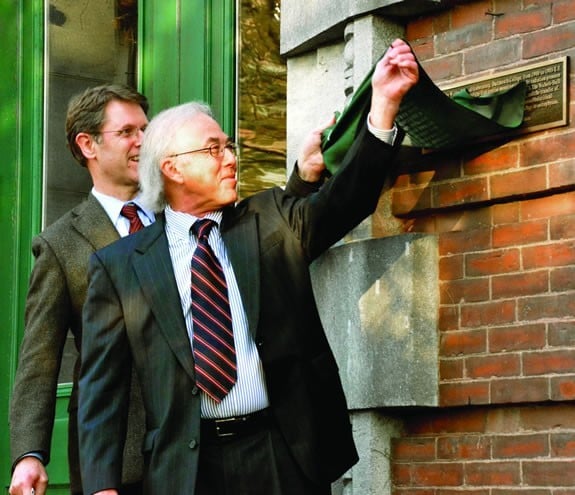Wilder Physical Laboratory
Hanover, New Hampshire

Ground-breaking experiments at Dartmouth College that demonstrated the pressure of light and the transfer of momentum between light and matter were recognized by the APS Historic Sites Initiative. On October 5, 2012, APS Treasurer/Publisher (and Dartmouth alumnus) Joseph Serene presented a plaque to Dartmouth that was accepted by Dartmouth Provost and Francis and Mildred Sears Professor of Physics Martin Wybourne, in recognition of the work undertaken by Ernest Fox Nichols and Gordon Ferrie Hull early in the 20th century. The citation reads: "At this site, the Wilder Physical Laboratory, Dartmouth College, from 1900-1903 E. F. Nichols and G. F. Hull performed the first precise measurement of the radiation pressure of light on a macroscopic body, as predicted by J. C. Maxwell in 1873. The Nichols-Hull experiment provided convincing evidence for the pressure of light, and the transfer of momentum between light and matter, a phenomenon which has enabled critical developments in a wide range of fields from atomic physics to biology to astrophysics."
James Clerk Maxwell had predicted this phenomenon in 1873 based upon calculated stresses in the electromagnetic field, and it had also been predicted by Adolpho Bartoli in 1876 based on a thermodynamics argument. All earlier attempts to experimentally observe this effect had been thwarted due to the disturbing action of the residual gases surrounding the body upon which the radiation fell, even in the best vacuums achievable at the time. The radiation pressure was predicted to be the energy density in the light beam, independent of the wavelength.
The experiments of Nichols and Hull succeeded, where others had failed, by making a detailed empirical analysis of the ubiquitous gas heating and ballistic effects. The published papers [Nichols, E. F., and Hull, G. F., "A preliminary communication on the pressure of heat and light radiation", Phys. Rev. 13, 307 (1901); "The Pressure Due to Radiation. (Second Paper.)", Phys. Rev. 17, 26 (1903)] reveal the incredible experimental acumen of the duo. The final results agreed with Maxwell's theory to better than one percent. The tiny force involved in their torsion balance radiometer was of order 10-4 dyne. (A dyne is approximately the weight of a postage stamp.)
So convincing were the results of Nichols and Hull that by 1910, review articles and textbooks, especially astronomy texts discussing the pressure of light as the force bending comets' tails, routinely referred to Maxwell's prediction and to Nichols' and Hull's experimental confirmation of light pressure [see Lewis, G., "A revision of the fundamental laws of matter and energy", Phil. Mag. 6th ser., 16, 706 (1908); Page, L., "A century's progress in physics", Am. J. of Sci, 4th ser., 46, 316-17 (1918); Russell, Dugan, and Stewart, "Astronomy"(1927), 478].
Radiative forces of light have since found many applications including laser cooling, trapping, and manipulation (optical tweezers) of neutral atoms and molecules. Radiative forces are used to manipulate atoms to form exotic states of matter, such as Bose-Einstein condensates, optical molasses and optical crystals, and to facilitate delicate high precision atom beam interferometers. The radiation pressure of soft x-rays is the basis for nuclear fusion confinement in the Teller-Ulam method of hydrogen-weapon technology.
Recently, there has been a significant growing effort to perform the quantum version of the Nichols-Hull experiment, in particular to measure the photon shot noise force on a macroscopic object. The pioneering work of Nichols and Hull, and of Lebedev, is cited in recent optomechanics papers, workshops, conferences and Nobel Lectures [see for example, the one of W. D. Phillips (1997)]. It is clearly recognized as the starting point for all modern radiative force techniques in the manipulation of atoms and macroscopic bodies.
In 1904, Nichols was awarded the Rumford Prize by the American Academy of Arts and Sciences "for his research on radiation, particularly on the pressure due to radiation, the heat of the stars, and the infrared spectrum."
Today, the Wilder Physical laboratory is still used for research and teaching. The Nichols radiometer in its original bell jar is on display at the Smithsonian Institution in Washington, DC. A number of artifacts (galvanometers, Wheatstone bridges, ruling engines, etc) used by Nichols and Hull are preserved in the King Collection of historic physics instruments at Dartmouth [see Pantalony, Kremer and Manasek, "Study, Measure, Experiment: Stories of Scientific Instruments at Dartmouth College" (2005)]. The original log books of the Nichols-Hull experiment are preserved in the Rauner Library in Hanover.
The Nichols-Hull experiments were a tour de force when they were performed, and they remain so today. Any experimentalist who reads the original papers will be amazed at the skill, attention to detail and the level of sensitivity and numerical accuracy achieved by Nichols and Hull with such basic equipment.1
Werner, S. A, Kremer, R. L., Blencowe, M., "APS Historic Site Application for the Nichols-Hull Experiment on the Pressure of Light, Wilder Physical Laboratory, Dartmouth College, Hanover, New Hampshire," October 17, 2011.